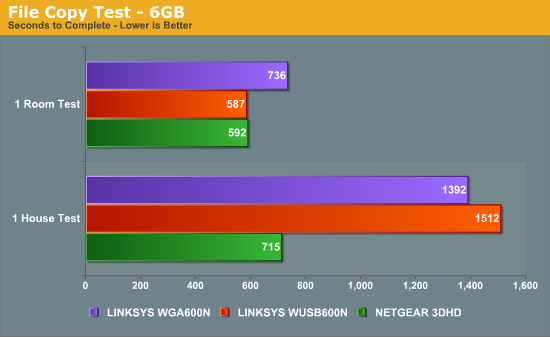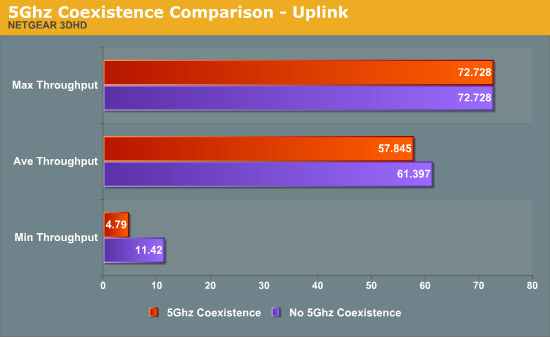Netgear 3DHD Wireless Home Theatre Networking Kit
by Cameron Butterfield on February 25, 2011 7:20 PM EST- Posted in
- Networking
- Home Theater
- NetGear
Real World File Copy Testing:
While IxChariot is good for measuring some characteristics of performance, we also performed some additional tests. First, a series of files totaling 6GB was transferred and timed over each of the device pairs. The numbers here reflect real world data transfers. We skipped the "ideal" 5 feet scenario this time as that didn't seem to be very important.
The interesting thing is that even though the Ixia Endpoint testing showed the WUSB600N performing much faster during the theoretical benchmark tests, here in the file copy test it only just outperforms the 3DHD device. Both of the leading devices at the one room testing range are transfering data at what equates to 83 Mbps. At location three, full house testing, we see some clear results. While the NETGEAR 3DHD pair is boasting around 69 Mbps, the other two devices have slowed to 32 Mbps.

5GHz Coexistence:
NETGEAR is marketing the 3DHD as a solution that can be added to existing wireless networks. Since the majority of wireless networks are based on the 2.4GHz range and this device operates on the 5GHz spectrum, the NETGEAR devices should not impact the existing 2.4GHz network. However, some users are utilizing 5GHz wireless routers already. Testing was performed to see if the performance of the NETGEAR 3DHD was impacted when using other 5GHz network devices at the same time.


In both the downlink and uplink tests, comparing when other 5GHz devices are present and when they are not present, there is minimal variation. This minimal impact may be due in part to the spacial beamforming features of the 4x4 MIMO technology that NETGEAR has implemented.










37 Comments
View All Comments
ChronoReverse - Friday, February 25, 2011 - link
Why do the positions of the tested devices vary across each chart? It would be much better if the NETGEAR 3DHD was always the first one in each graph.JarredWalton - Friday, February 25, 2011 - link
It's a glitch with the multibar charts in our engine. Sorry.Slash3 - Saturday, February 26, 2011 - link
30 seconds in MS Paint's cut/paste can reverse the positions. :)JarredWalton - Saturday, February 26, 2011 - link
30 seconds in the graphing engine. Then save that image from your browser onto your drive. Open that image up in Paint (or more likely, Photoshop). Then rearrange the bars so that they're in the positions you desire. Don't mess up the text or the spacing of the bars. When you're done, save the file, upload it back to the server, and then modify the HTML to reference the appropriate file. Yeehaw! I'd guess more like 5 minutes. Now do that for every graph you want to modify.I'll make a note to our engine guy that sorting of multi-series charts doesn't work. Then hopefully we can get that fixed for the future. Having done manual creation of charts in the past, though, I can tell you that it isn't even remotely fun. In fact, the old graphing engine was seriously one of my least liked parts of writing articles. The new engine is worlds better, but it isn't perfect.
LeftSide - Friday, February 25, 2011 - link
Wow, I wireless device that is reliable, has consistent throughput, and is easy to set up. This is a first.danjw - Friday, February 25, 2011 - link
You mention that for short range there were lower priced options that performed just as well for wireless HDMI, so which ones are those?nubie - Friday, February 25, 2011 - link
I think he meant that the other devices it was compared to, not HDMI links.If you needed to go one room over, or through one wall or floor, the other devices reviewed were faster.
Kyser Soze - Friday, February 25, 2011 - link
It's testament to the quality of anandtech's site that they check throughput on various levels of emotional content in films. No other tech sites offer this service. I for one am looking forward to finding out if some stuttering occurs during the Shawshank Redemption, but not, for instance, in Attack of the Clones.Can my old netgear handle romantic comedies?
queequeg99 - Friday, February 25, 2011 - link
This is a pretty funny comment. Did the author intend to refer to a detailed scene with lots of movement?Exelius - Friday, February 25, 2011 - link
If you're somewhat technical, just pick up a pair of compatible wireless devices and load them with DD-WRT, then set one of them up in bridge mode.I have a pair of 5 year old Linksys WRT54Gs that I have doing exactly this. Throughput isn't spectacular by ethernet standards (averages about 30 mbps) but it's more than enough to stream 720p Netflix to my PS3. The devices are about 50 feet apart and cost me about $300... 5 years ago. They can certainly be found for less now. Bonus with DD-WRT is that you can basically "overclock" the wireless radios and operate them with a higher signal strength (though be careful; heat quickly becomes an issue and the case on one of my devices is warped from high heat output in a poorly ventilated area.)
I'm sure this solution is easier to set up, but honestly, it's a set-it-and-forget-it solution. Any self-respecting tech nerd should be able to set this up in an hour or two and enjoy the fruits for years. That said, wireless links can be finicky and a pain in the ass to diagnose when things go wrong, so wired is always preferable even when speed isn't a factor (it doesn't get screwed up by using the microwave.)